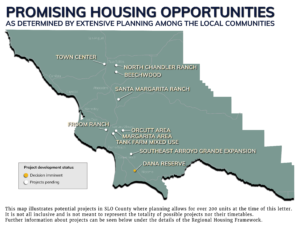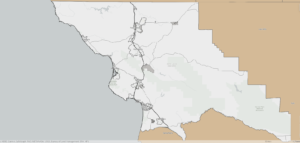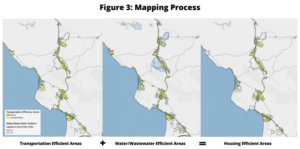We all know we have a housing problem.
Let's get to work.
An urgent call to approve and move on the housing our families, workforce, and economy desperately need
Space Vandenberg | Launching a new era of opportunity for the Central Coast
An urgent call to approve and move on the housing our families, workforce, and economy desperately need
SLO County’s persistent housing shortage has become a fundamental threat to our community’s livelihood. Businesses can’t hire, workers can’t afford to live here, and our economy can’t sustain our way of life.
As members of the housing advocacy team and partners that supported development of the new Housing and Infrastructure Regional Framework, we believe that swift leadership to create more housing is an economic imperative.
We applaud the regional coordination of SLOCOG, the County and the seven cities in developing new strategies and tools to counteract the overwhelming challenges we face — and we urge you to take action now to approve and move forward on housing of all types and in all stages of development.

Decades of inaction have compounded the housing shortage and thwarted our ability to grow and thrive. As we look at our region’s project pipeline it is essential that we resist the tendency to delay or deny the housing we need.
We must work urgently at every stage to build the homes and neighborhoods that our teachers, public servants, service workers, nurses and doctors, small business owners and beyond desperately need — moving projects through the planning pipeline more quickly and approving them without delay. Not in 2 years. Not in 5 years. Today.
Before us right now and in the months ahead are housing projects such as the Dana Reserve in Nipomo, Margarita Area in SLO, and North Chandler Ranch in Paso Robles that will create homes for thousands of families and begin to bridge the huge housing gap straining every facet of our community and economy.
Regional planning shows potential to activate the creation of 15,714 homes and apartments across SLO County. And we have the foundation for action.
SLO County, the seven cities and SLOCOG set the stage with the 2020 Regional Compact, a shared commitment to developing the housing and infrastructure needed to support the economy. Earlier this year, more than 100 private and public sector stakeholders worked collaboratively over the course of 52 meetings to develop the next major milestone: the Housing and Infrastructure Regional Framework, a planning tool that aligns regional priorities around proposed projects and opportunities.
We have the plan and tools to do the job. Each community has a role and responsibility, spanning the government leaders who are indispensable in making housing a reality to the community members needed to champion it. And region-wide collaboration will be essential to measure our progress, share best practices, and mobilize resources toward housing and supporting infrastructure.
Local government leaders should revisit policies such as density limits and parking requirements, streamline review processes and move on infrastructure projects to unlock longer-term housing opportunities.
Community members have a critical role to play in voicing support by showing up in the public square to ensure we collectively stay true to the north star of creating more housing that’s attainable for our residents and supports our community’s future.
We have the organizations and partners committed to supporting and advancing this vital community dialogue. We have a new framework and tools to leverage and a foundation of collaboration to channel our efforts efficiently and effectively.
The time is now. Let’s respond with unity, urgency, and unwavering determination to secure a bright future for all.
Sincerely,
Ken Trigueiro
President & CEO, People’s Self-Help Housing
Jim Dantona
President & CEO, SLO Chamber of Commerce
Nick Rasmussen
Chief Executive Officer, Habitat for Humanity
Lindy Hatcher
Executive Director, Home Builders Association
Chuck Davison
President & CEO, Visit SLO CAL
Jocelyn Brennan
Government Affairs Director, San Luis Obispo County Realtors Region 31
Melissa James
President & CEO, REACH
Scott Collins
Executive Director, Housing Authority of SLO
Jeff Eckles
CEO, San Luis Obispo Housing Trust Fund
Lenny Grant, BD&C Co-Chair
Co-Chair, Building Design + Construction council
Kathy McCorry
CEO, South County Chambers of Commerce
Krista Jeffries
Lead Organizer, SLO County YIMBY
Steve Delmartini
Broker, Housing Advocate
The Housing & Infrastructure Regional Framework (Framework), is a planning toolkit collaboratively created by the seven cities, County of San Luis Obispo, and SLOCOG in response to the region’s growing housing and infrastructure shortage. Building off of the work laid out in the 2020 Regional Compact, it is the first planning tool of its kind, and it is intended to be a living document. For the last five years, collaboration has continued to build, and these incremental steps have allowed the region to make progress in addressing these monumental challenges.
Our region has strategic goals for the future of housing and infrastructure, but they can only be achieved through the decisions and actions of organizations and stakeholders. The stakeholder meetings are designed to have honest conversations about what each organization can and needs to do to realize those goals. Key stakeholders include:
Debbie Arnold, County District 5 Supervisor
Andy Pease, City of San Luis Obispo Council Member
John Peschong, County District 1 Supervisor
Bruce Gibson, County District 2 Supervisor
Dawn Ortiz Legg, County District 3 Supervisor
Jimmy Paulding, County District 4 Supervisor
Jim Guthrie, Arroyo Grande Council Member
Heather Moreno, Atascadero Mayor
Daniel Rushing, Grover Beach Council Member
Carla Wixom, Morro Bay Mayor
Fred Strong, Paso Robles Council Member
Ed Waage, Pismo Beach Mayor
Scott Eades, Caltrans District 5 Director
Formed to oversee the vision for the HIP Outreach Strategy and to bring leaders in each of these areas together, aligning and integrating the various interests that will lead to action on the region’s priorities.
Matthew Bronson, City of Grover Beach
Heather Moreno, City of Atascadero
Andy Pease, City of SLO
Trevor Keith, SLO County
Aaryn Abbot, Abbott | Reed
Lenny Grant, RRM
Jeff Eckles, SLOCHTF
Courtney Howard, SLOCFCWCD/County
Anthony Palazzo, Cal Poly
Jorge Aguilar, Wallace Group
A key driving force behind developing this plan has been regional leadership, including eight city managers, county administrative officer, SLOCOG executive director (and key directors from their organizations).
John Nilon, County of SLO
Rebecca Campbell, County of SLO
Whitney McDonald, Arroyo Grande
Matthew Bronson, Grover Beach
Greg Carpenter, Morro Bay
Sarah Johnson-Rios, Morro Bay
Ty Lewis, Paso Robles
Derek Johnson, City of San Luis Obispo
James Lewis, Pismo Beach/Atascadero
Jorge Garcia, Pismo Beach
Scott Collins, Morro Bay
Wade Horton, County of SLO
Rachelle Rickard, Atascadero
Leaders in the building and development industry convene quarterly with the goal of regional coordination focused on aligning housing and infrastructure needs to create a strong local economy.
Abbott | Reed Inc.
Covelop
Specialty Construction
Wallace Group
The HRM Corp.
Ten Over Studio
People’s Self Help Housing
RRM Design Group
Vivian Hanover Ventures Real Estate
Home Builders Association of the Central Coast
City of San Luis Obispo
County of San Luis Obispo
California Polytechnic University (Cal Poly)
First American Title Company, San Luis Obispo
Kovesdi Consulting
Guaranteed Rate
Omni Design Group
RRM Design Group
Midland Pacific Homes
Z Villages Management and Development
NKT Commercial
Organizations and individuals that have significant influence in the community, with representation from the non-profit builders, local chambers of commerce and various advocate organizations.
Ken Trigueiro, Peoples’ Self-Help Housing
Scott Collins, Housing Authority of SLO (HASLO)
David Cooke, Paso Robles Housing Authority
Jocelyn Brennan, California Association of Realtors Region 31
Steve DelMartini, Compass Real Estate
Jeff Eckles, San Luis Obispo County Housing Trust Fund
Nick Rasmussen, Habitat for Humanity
Lindy Hatcher, Home Builders Association
Krista Jeffries, YIMBY
Jim Dantona, SLO Chamber of Commerce
Erica Crawford, Morro Bay Chamber of Commerce
Glenn Silloway, League of Women Voters
Existing work group made up of planning/ community development staff from cities, county, and SLOCOG.
Cory Hanh, County of SLO
Warren Frace, City of Paso Robles
Darcy Delgado, City of Paso Robles
Katie Banister, City of Paso Robles
Phil Dunsmore, City of Atascadero
Kelly Gleason, City of Atascadero
Scot Graham, City of Morro Bay
Nancy Hubbard, City of Morro Bay
Bruce Buckingham, City of Grover Beach
Matt Downing, City of Pismo Beach
Megan Martin, City of Pismo Beach
Andrew Perez, City of Arroyo Grande
Brian Pedrotti, City of Arroyo Grande
Owen Goode, City of SLO
Teresa McClish, City of SLO
Kyle Bell, City of SLO
Pete Rodgers, Executive Director
James Worthley, Planning Division Chief
Sara Sanders, Regional Framework Project Manager
Jayden Hermansen, Mapping Tool Architect
Ashley Edwards, Grant Administration
Alan Cazares, Water Projects Data Collection
Carolyn Berg, Koble Collaborative
Michael Foote, REACH
Russ Levanway, REACH
Melissa James, REACH
Becky Hewitt
Emmanuel Lopez
Rasik Hussain
Jamil Ditter
Chelsiah Scouras
Marley Mueller
Doug Flemin

Further details on all projects can be viewed here.
No one city can do enough to address the shortfall of housing supply in our region alone. We need commitments from each jurisdiction and the development and building community to work together to address our challenges. This plan moves us forward by taking an analyzed approach to prioritizing those needed infrastructure projects in our communities that can most impactfully remove barriers to increasing housing supply.
The Housing Infrastructure Analysis looks at three efficiency factors: transportation access, water capacity, and wastewater capacity. By combining the three efficiency factors, housing efficient areas were identified. This is graphically represented in Figure 3: Mapping Process. Any infrastructure projects located in the “efficient” or “potential” mapped areas moved on to the prioritization phase.
All areas and projects that were considered “limited” were removed from further analysis. The Framework in no way removes land use authority from local jurisdictions or changes zoning of an area. The Communities of Shandon, Avila Beach, and Cambria were removed from analysis since they did not meet the efficiency criteria.

Examples:
Progress can be seen across the county, from regional leadership and collaboration on housing to growing political and community support. Planners are embracing density and reducing barriers, and new projects are getting built. Here are some highlights.
The Framework provided an analysis of what Affordable-By-Design means in SLO County and showed what many of us intuitively knew, that it is both expensive to live here and build here. The study laid out a menu of options for policies and actions that each community could pursue. While we cannot highlight all possible tools available or actions needed, the following are some near-term, impactful items that could be focused on, both immediate and long term, such as:
The words used around housing can be confusing — we all have varying perceptions of what constitutes affordable, and even when used by government, terms like workforce housing can have different definitions across jurisdictions.
Our work at REACH targets housing that’s attainable by the region’s working population. That’s teachers, nurses, firefighters and service members, but also the tech workers, sales reps, engineers and fabricators our businesses need to expand.
That said, low-income housing and solutions to homelessness are important pieces of the puzzle. While not the focus of our work, we broadly support these efforts and our partners who are deeply engaged with them.
A whole host of factors has contributed to the shortage of housing in communities across the state and country. Labor and material costs, zoning regulations, onerous approval processes and environmental requirements, NIMBYism, vacation rentals, corporate ownership — the list could go on.
But the bottom line is this: Like many of those other communities, home building on the Central Coast simply has not kept pace with population and job growth.
In concrete terms, it’s about whether businesses can attract and retain workers to fill jobs.
Whether or not you are concerned with job growth, the impact takes a toll not just on business conditions but day-to-day life on the Central Coast.
The quality of life in a community that can’t house its workers is not sustainable in the long run.
All we mean here by infrastructure is roads, water and wastewater service — things you need before you can build new homes. In many places across the Central Coast, new homes can’t be built because these pieces are lacking and need to be put in place to, ahem, pave the way for homes.
So, addressing housing often means first addressing the underlying infrastructure needed to enable it.